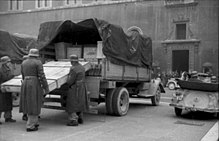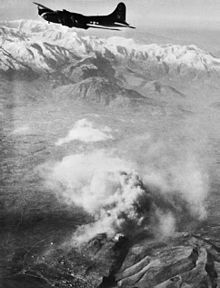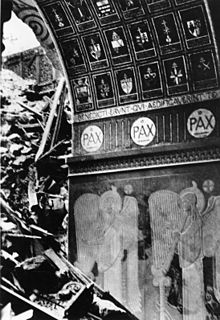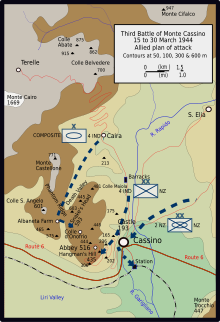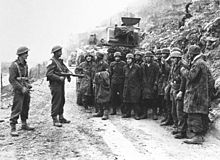Battle for Monte Cassino
| date | January 17 to May 18, 1944 |
|---|---|
| place | Montecassino Abbey ( Italy ) |
| output | Allied victory |
| Parties to the conflict | |
|---|---|
|
Allies : United Kingdom Canada United States Polish Government-in-Exile New Zealand British India Free France |
|
| Commander | |
|
|
|
| Troop strength | |
|
5th US Army and British 8th Army around 240,000 men |
10th Army about 140,000 men |
| losses | |
|
55,000 soldiers |
20,000 soldiers |
1940–1945: Air raids on Italy
1940: Attack on Taranto
1943: Operation Husky - Invasion of Italy ( Baytown , Avalanche , Slapstick ) - Armistice of Cassibile - Fall of the Axis
1944: Battle of Monte Cassino - Operation Shingle - Position of Goth
1945: Spring Offensive
The battle for Monte Cassino from January 17th to May 18th 1944 was one of the longest battles of the Second World War with four months and heavy losses on both sides.
Starting position
At the beginning of January 1944, the 5th US Army under Lieutenant General Clark had reached the Gustav Line along the Garigliano and met the resistance of the German XIV Panzer Corps under General von Senger and Etterlin . For operational reasons, the western defense positions were most strongly developed, because the advance of the Allies through the Liri valley in the direction of the Italian capital Rome was to be prevented. In fact, their advance came to a standstill despite the enormous superiority of people and material on the line in front of Cassino .
The Montecassino formed an important base of the German Gustav Line, which ran across Italy. The hill gave the Germans a wide field of vision and field of fire. The 1,300-year-old Benedictine monastery is located on the top of the mountain at a height of 516 meters . Because of its special historical importance, the German commander- in -chief in Italy, Field Marshal Albert Kesselring , had forbidden to include the monastery in the German positions. The German paratroopers set up their defensive positions 300 meters from the buildings in the mountainside and obeyed orders not to approach the monastery any further. Kesselring let the Allies know about this decision. They initially assumed a ruse, but found no evidence of German troops in the monastery during the fighting.
First battle on the Garigliano and the Rapido
On January 17, 1944, the 5th US Army began attacking the German positions. On the left wing, which ran as far as the coast, the British X. Corps under General McCreery began the advance with the 5th Division over the Garigliano and wrested the town of Minturno from the German 94th Infantry Division the following day . Attacks by the British 56th Division on Castelforte and later attempts by the 46th Division to overcome the Garigliano at the river knee failed after the intervention of the 29th and 90th Panzer Grenadier Divisions . In the main attack area, Clark deployed the II. US Corps under Major General Keyes head-on: on the left, the 36th US Division under Major General Walker was supposed to force direct access in the Lirital towards Via Casilina (Route 6), on the right the 34th US -Division under Major General Ryder was assigned to the northern enclosure of the Cassinoberg over Monte Castellone and Monte Maiola. The southern advance was unsuccessful because of the resistance of the German 15th Panzer Grenadier Division and brought heavy losses to the attacking US units. The Austrian 44th Grenadier Division under Lieutenant General Franek held on to Monte Cassino and the Cairo Massif, while the 5th Mountain Division to the north under General Ringel held up successfully on Monte Croce at an altitude of 1074 meters and on Monte Cifalco. On January 25, the 34th US Division tried to break through in a new attack on Rocca Janula . The voluntary French Corps under General Juin supported the right wing by attacking Monte Belvedere. On January 28, the worn out 44th Grenadier Division had to be replaced by the 90th Panzer Grenadier Division, vacated at Garigliano, which took over the defense from Cassino to the Secco Valley. The Americans withdrew after their long-lasting offensive in front of Cassino and were replaced on February 12th by the 2nd New Zealand Corps under Lieutenant General Bernard Freyberg .
Second battle - Operation Avenger
For Operation Avenger , which was due to begin on February 15, General Freyberg's plan again provided for a direct attack on the Cassino position. From the north the Indian 4th Division under Brigadier General Dimoline was supposed to advance along the ridge and in the southeast the New Zealanders had to advance along the railway line and the train station over the Rapido. For this attack directly south of Cassino , the commander of the New Zealand 2nd Division, Major General Kippenberger , demanded the bombing of the German positions and the monastery, in which - without evidence - a German radio station was suspected. In fact, the monastery was not occupied by German units. A large bypass of Cassino, which would have made the monastery militarily insignificant, came for General Alexander , the Allied Commander in Chief of the XV. Army Group, out of consideration.
Destruction of the monastery
In the meantime, the Commander-in-Chief of the German 10th Army , Colonel General Heinrich von Vietinghoff, had entrusted the 1st Paratrooper Division under Lieutenant General Richard Heidrich with the defense of the city and the mountain. The overall command here was incumbent on the LI General Command . Mountain Corps under General of the Feurstein Mountain Troop .
As the Allies pushed further north towards the monastery, troops from the Parachute Panzer Division Hermann Göring under Lieutenant Colonel Julius Schlegel made themselves available to the monks of the monastery to display the unique cultural treasures, including around 1200 historical books and documents, and pictures by Leonardo Vinci , Titian and Raffael as well as the mortal remains of Benedict of Nursia were to be brought to safety in Rome before the attack in Castel Sant'Angelo . However, the cultural assets of the monastery were not only saved by German troops, but in some cases also stolen. After the end of the war, 13 masterpieces from Montecassino were found in a tunnel in the Altaussee salt mine , where Hitler and Göring housed their art collections.
After the first heavy losses, General Freyberg asked the Americans for air support; they agreed. The reasons for this decision are unclear. The day before the air strike, the Allies issued leaflets to inform the people present in the monastery and urge them to leave the abbey.
On February 15, 225 US bombers of the 12th and 15th Air Force dropped a total of 435, according to other sources, 567 tons of explosive and incendiary bombs on the monastery complex in two waves of attack . Together with additional artillery fire, the monastery was completely destroyed within three hours with the exception of the crypt . At the beginning of the attacks there were around 800 people in the monastery and its vaulted cellars, the majority of whom were monks and refugees seeking protection, 250 of whom, according to other sources, 427 were victims of the bombing.
The survivors, the monks with their abbot and the civilians, now left the destroyed monastery. As a result, German troops occupied the ruins of the monastery on February 17th and included them in their defensive positions. In the next few months they were able to hold the mountain - despite further heavy attacks and with high losses on both sides - until May 18th.
The destruction of the monastery, the months in which the positions were held and the high allied losses were used by German war reporting to strengthen the morale of the troops and the population in times of retreat and to discredit the enemy . The Vatican declared that there were neither German soldiers nor military equipment in the monastery before the bombing, thus confirming the representation of the German side. To justify it, US President Franklin D. Roosevelt stated untruthfully that the abbey was an artillery base for the Germans and that its destruction was therefore militarily necessary; Henry H. Arnold , Commander in Chief of the US Army Air Forces, called the bombing a "symbol of the destructive power of the Air Force". The destruction of the monastery caused considerable diplomatic resentment between the Holy See and the Western Allies.
Third battle - Operation Dickens
The third Allied offensive operation followed between March 15 and 23; the focus was again on the 2nd New Zealand Corps, this time concentrated on a front only 1.5 kilometers. The assigned British 78th Division under Major General Keightley should follow up after initial successes and force the breakthrough into the Lirital. After the use of 575 bombers and 200 fighter bombers, the barrage of 746 guns followed, the entire force of the bombing was concentrated against the narrow attack section. The deployed 3rd German Paratrooper Regiment under Colonel Heilmann was almost completely destroyed. An attack against the Rocca Janula by the Indian 4th Division , now under Lieutenant General Alexander Galloway , who was supported by the New Zealand 4th Panzer Brigade, finally conquered the contested height 193. General Heidrich used his reserves and could only do more after the Allied attack secure a third of the town of Cassino. German counter-attacks on March 17 and 19 against enemy break-ins at Monte Calvario and at the Cassino train station were unsuccessful and only resulted in heavy losses. The British 78th Division, which moved forward on March 20, was unable to break the resistance of the German paratroopers.
On March 23, General Alexander stopped the senseless attacks. In addition, a three-week period of rain forced the operation to be completely abandoned, and on March 24, winter returned to southern Abruzzo . The time was used by the Allies for extensive reorganization of the command areas. Most of the British 8th Army, under the command of Lieutenant General Oliver Leese, took command on both sides of Cassino. The planned Operation Diadem was supposed to start before the invasion of Normandy in order to tie up German troops in Italy.
Fourth battle - Operation Diadem
On May 11, 1944 at 11 p.m. local time, the decisive Allied final offensive began, the attack was planned from the sea to beyond Cassino over a width of 32 kilometers with four corps. A massive artillery bombardment with 1060 cannons of the 8th Army and 600 cannons of the 5th US Army initiated the infantry storm from 11:45 p.m. The Liri section formed the army border between the 5th US Army and the British 8th Army: Poles and British stood on the northern section on either side of Cassino on the Rapido, the French (Algerians and Moroccans) and Americans south of it to Minturno on the right bank of the Garigliano .
The British XIII. Corps under General Kirkman from the British 4th , 78th and Indian 8th Divisions succeeded in bypassing the mountain from the south and thus breaking into the Gustav Line , which the German paratroopers could no longer hold. While the majority of the units on the left and right began to bypass the mountain, the 2nd Polish Corps under Lieutenant General Władysław Anders was given the task of attacking the monastery ruins from the front. The Syrian brown bear Wojtek , who had been captured and adopted in Iran by artillery soldiers of the 2nd Polish Corps and had accompanied the troops since 1942, carried boxes of mortar shells across the impassable battlefield.
On the morning of May 17, the Polish 5th Division attacking north of Sassino occupied the Colle Sant 'Angelo, the Polish 3rd Division captured the mountain 593.
The 2nd US Corps from the 85th and 88th US Divisions and the French Expeditionary Corps under General Juin meanwhile broke through the front of the German 71st and 94th Infantry Divisions on the south wing . The Algerian 3rd Division under General Goislard de Monsabert took Castelforte and broke through to Ausonia by May 14th .
Due to the persistent, albeit loss-making, Polish advances, the catastrophic own losses and the changing overall military situation in Italy, Commander-in-Chief Kesselring ordered the rest of his paratroopers to abandon Monte Cassino on May 17th. About 100 paratroopers surrendered to the British, others tried to break out of the cauldron. On the morning of May 18, the Germans hoisted the white flag. After the Polish units had taken the ruins of the monastery without a fight, Lieutenant Kazimierz Gurbiel raised the Polish flag on the ruins of the monastery at 9:50 a.m. The Polish corps alone had lost 281 officers and 3503 men in a three-day battle in the final offensive.
In the Lirital, after the tactical breakthrough of the British 78th Division, which led to the capture of the town of Pignataro on May 15 and of Piumarola on May 17, the Canadian 1st Corps under General Burns followed up on Pontecorvo .
meaning
The long, very costly battle stopped the advance of the Allies. When the Monte Cassino obstacle was overcome, the Allied advance was continued with Operation Shingle . On May 25, the II. US Corps, coming from the east, established the connection with the VI. US Corps in the Anzio bridgehead. On June 4, the 1st US Armored Division and the 36th US Division marched without a fight into Rome, which had previously been declared an open city .
Around 20,000 died in the battle for the city and mountain of Cassino, in which 105,000 allies, including US, British, French, Polish, Anglo-Indian, New Zealand, Algerian, Moroccan, Gurkhas , and 80,000 German soldiers fought German and up to 55,000 Allied soldiers.
After the battle, the morale of the German paratroopers was glorified in Nazi propaganda ; the German withdrawal was not mentioned.
In Poland, the conquest of the ruins of Monte Cassino is a national symbol of the death of thousands of Polish soldiers who lost their lives in exile on the side of the Allies for the liberation of Europe from National Socialism. The song Czerwone maki na Monte Cassino , German red poppy on Monte Cassino , glorifies the loss-making battle of the Polish corps.
In many countries the battle for Monte Cassino is synonymous with the futility of war; the destruction of the monastery as a memorial against war and for peace.
literature
- Alan Axelrod: Real History Of World War II: A New Look at the Past. Sterling Publishing, New York 2000, ISBN 978-1-4027-4090-9 .
- Katri'el Ben-Arie: The Battle of Monte Cassino 1944. 2nd edition, Rombach, Freiburg im Breisgau 1986, ISBN 3-7930-0188-1 .
- David Hapgood, David Richardson: Monte Cassino: The Story Of The Most Controversial Battle Of World War II. Da Capo Press, Cambridge, MA 2002, ISBN 978-0-306-81121-0 .
- Emmanuel Munding: The downfall of Montecassino on February 15, 1944. In: Testimony of the Spirit. Gift for Benedictus = Jubilee, 547–1947, supplement to XXIII. Volume of the Benedictine monthly , Beuroner Kunstverlag, Beuron 1947, pp. 112-138.
- Gerhard Muhm: La tattica tedesca nella campagna d'Italia. In: Linea gotica avamposto dei Balcani , a cura di Amedeo Montemaggi - Edizioni Civitas, Roma 1993 ( excerpt ).
- Janusz Piekałkiewicz : The Battle of Monte Cassino. Twenty peoples are fighting over a mountain. Bechtermünz, Augsburg 1997, ISBN 3-86047-909-1 .
- Eric D. Smith: The battle for Monte Cassino 1944 (original title: The Battel of Monte Cassino , translated by Rainer Buschmann). Motorbuch, Stuttgart 1979 ISBN 3-87943-629-0 / 2. Edition 1985, ISBN 3-613-01095-X (formally incorrect ISBN).
- Wolfgang Wallenda: The front soldiers from Monte Cassino. Triga, Gründau-Rothenbergen 2009, ISBN 978-3-89774-717-3 .
- Luca Villoresi: Barbarigo Teschi e memorie . In: La Repubblica . No. 3 June 1994, accessed March 9, 2009, August.
Movies
- The green devils of Monte Cassino . Germany 1958
See also
- Operation Shingle / Battle of Anzio
Individual evidence
- ↑ Luca Villoresi: Barbarigo Teschi e memorie . In: La Repubblica . No. 3 June 1994, p. 35, August.
- ^ Alan Axelrod: Real History Of World War II: A New Look at the Past. 2008, p. 208.
- ↑ Ronald Schaffer: Wings of judgment - American Bombing in World War II , Oxford 1985, ISBN 0-19-505640-X , p. 51ff.
- ↑ a b Gerhard Schreiber : The end of the North African campaign and the war in Italy 1943 to 1945. In: Karl-Heinz Frieser , Klaus Schmider , Klaus Schönherr , Gerhard Schreiber, Krisztián Ungváry , Bernd Wegner : The German Reich and the Second World War , Vol. 8: The Eastern Front 1943/44 - The War in the East and on the Secondary Fronts. on behalf of the MGFA ed. by Karl-Heinz Frieser, Deutsche Verlags-Anstalt , Stuttgart 2007, ISBN 978-3-421-06235-2 , pp. 1146ff.
- ↑ David Hapgood, David Richardson: Monte Cassino: The Story Of The Most Controversial Battle Of World War II . Da Capo Press, ISBN 978-0-306-81121-0 . (engl.)
- ↑ Ronald Schaffer: Wings of judgment - American Bombing in World War II , Oxford 1985, ISBN 0-19-505640-X , p. 51ff.
Web links
- The Battle of Monte Cassino on the website of the German Historical Museum
- Long-distance camaraderie: Monte Cassino - What happened back then?
- Page no longer available , search in web archives: German Tactics in the Italian Campaign by Gerhard Muhm
- Report and photos of a visit to the Cassino military cemetery
- The destruction of Montecassino in 30 days in church and world
- Montecassino Abbey website (Italian / English)
- Website ( memento of December 8, 2007 in the Internet Archive ) about the Monte Cassino Abbey
Coordinates: 41 ° 29 ′ 24 ″ N , 13 ° 48 ′ 50 ″ E


